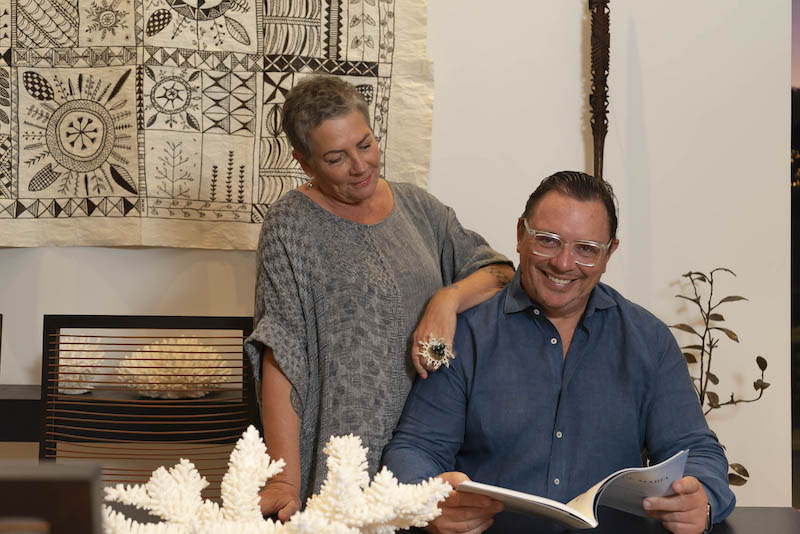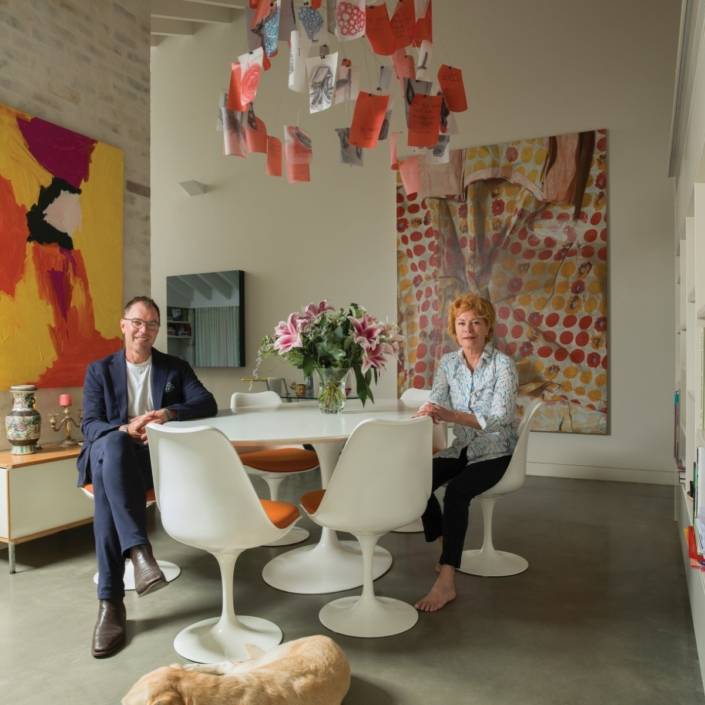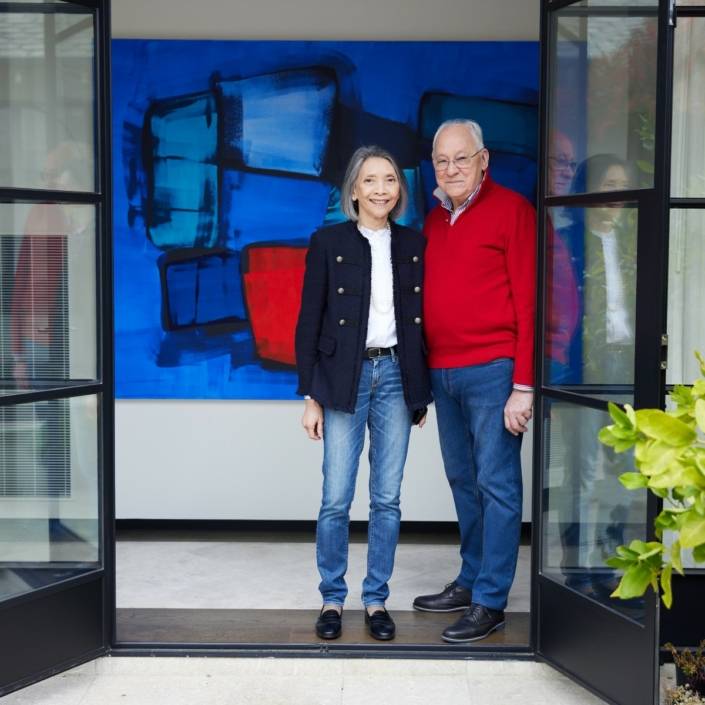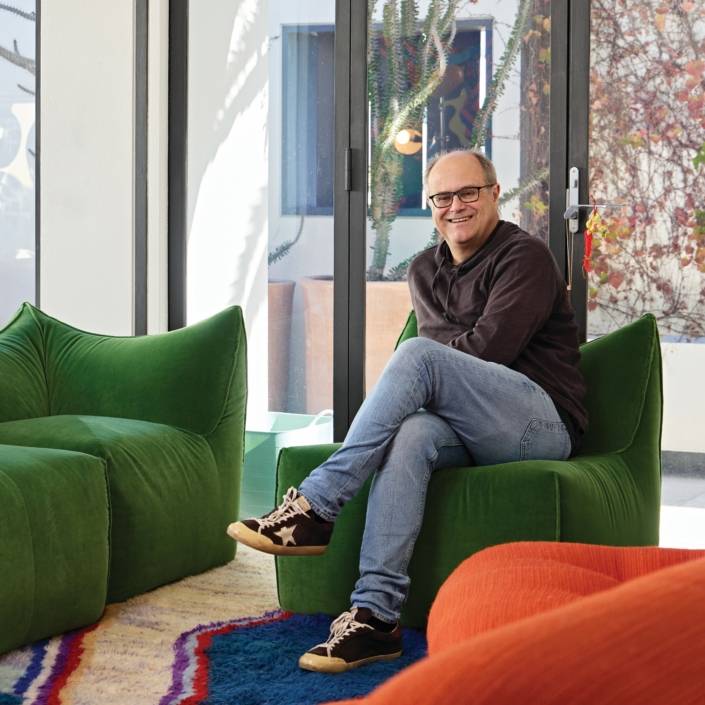Rose and John Dunn: Heart, Mind & Soul
The emotional and personal connections to the art in their Auckland home speak strongly to the way Rose and John Dunn approach life.
Words: Sue Gardiner
Photography: Kallan Macleod
“I am aware of having an aesthetic way of living that draws me almost immediately, with a strong intuitive pull, towards a work of art,” says Rose Dunn from her Auckland home, where she lives with husband John. “I am sensitive to situations, people and emotions in the world. I think of it as a holistic reaction – my heart, my mind and soul all speak to me, and I know an artwork is important to us.”
Rose continues as she reaches for a recent acquisition, a painted clay bowl by artist Star Gossage featuring images of sea urchins: “I get energy from being with art. All the senses are involved: olfactory, visual, spatial, textural. In turn, I feel a close visceral connection to nature and artists’ use of natural materials and patterns.”
Surrounding us as we talk is a feather lei by Emily Siddell, a smooth, rhythmic stone work by Chris Charteris, wooden furniture designed by Humphrey Ikin and a Moon Dreaming painting by Warmun artist Mabel Juli, using earth ochres and natural pigments. Close by is Michael Parekowhai’s The Moment of Cubism (2009), a bronze lemon tree sapling, and on almost every wall, impressive contemporary tapa made from the beaten bark of a mulberry tree.
“We have spent time really drilling down into what we want to live with and how we want to live, growing in confidence along the way, keeping an open mind,” says Rose. As a couple, Rose and John don’t feel the need to agree on every work they share, believing it is important to enable individual connections. As part of that journey, key works have entered their lives from artists such as Lonnie Hutchinson, Reuben Paterson, Geoff Thornley, Milan Mrkusich, Bill Hammond, Nonggirrnga Marawili, John Pule, Fatu Feu’u, Shane Cotton and Ralph Hotere. “Bill Hammond’s Melting Moments [1999] has a special place for me as the first major work I acquired,” Rose reflects.
For John, an Auckland surgeon drawn into the world of art by Rose’s deeply held passion, the close connection between art and life has become meaningful in the medical setting. “Art and wellbeing go hand in hand,” he muses. “Art, as a mind/body connection, is an important part of the healing process, and so we have an art collection in the surgery for patients and staff.”
For both John and Rose, this commitment to seek a deep connection with art goes a huge step further. John has ancestral family connections to The Cook Islands, conducting laparoscopic surgery at Rarotonga Hospital and, with Rose, establishing Motu, the first art resort in the Pacific. Five years ago, he embarked on the process of receiving the Pe’a, the traditional male tatau (tattoo). Covered from waist to knees, John comments that his “body has become a tapestry” as he shows me a glimpse of the remarkable transition his body has undergone. “We used the traditional Samoan practice of pe’a and incorporated rare Cook Island imagery. The tufuga ta tatau (master tattooist) lived with us with the process taking 100 hours. The nine-to-five schedule required a lot of family support.”
Photographer Mark Adams documented the process, having also taken the famous photographs of artist Tony Fomison, a Pakeha/palagi artist receiving his Pe’a in 1978. During the time with John, Adams noticed a strange thing. The small Tony Fomison artwork, Head of Christ, that John chose to have near him during the tatau process was the very same work that Fomison himself kept near him during the task 40 years earlier. The first work John acquired; it is a now a treasured work in their collection.
More links to tatau are found in drawings by John Pule, and the support given to artist Greg Semu, whose series Self Portrait with Side of P’ea, was photographed in the bathroom of their former home. A series of three photographs by Yuki Kihara, who represents New Zealand at the 2021 Venice Biennale, are important to Rose and John; they were early supporters of the artist’s.
Rose and John are deeply committed to supporting a range of Pacific artists through the work of the Tautai Pacific Arts Trust, an organisation founded in the 1980s by Samoan artist Fatu Feu’u. “If we can, it is important to us to know the artist as well as their work, and this is one reason we started Fetu Ta’i, a Tautai patrons group encouraging philanthropic support for Pacific artists,” says Rose. As John explains, “Auckland is the best place to connect to Pacific artists. You don’t find that rich vein of art anywhere else in the world, and it has been a wonderful world to gently move closer to over the years.”
This article was originally published in Art Collector issue 92, APR – JUN 2020.






